Strategic Management Approaches: Sustainable, Stakeholder, and Dynamic Capabilities
VerifiedAdded on 2023/04/24
|12
|3443
|206
AI Summary
This text appears to be an excerpt from a report on strategic management. The report discusses various approaches to strategic management, including the sustainable approach, stakeholder approach, and dynamic capabilities approach. These approaches are applied by organizations such as Adidas, The Coca-Cola Company, and Apple to manage their assets effectively, take into consideration the interests of all stakeholders, and exploit their external and internal competencies to deal with rapid changes in the environment.
Contribute Materials
Your contribution can guide someone’s learning journey. Share your
documents today.
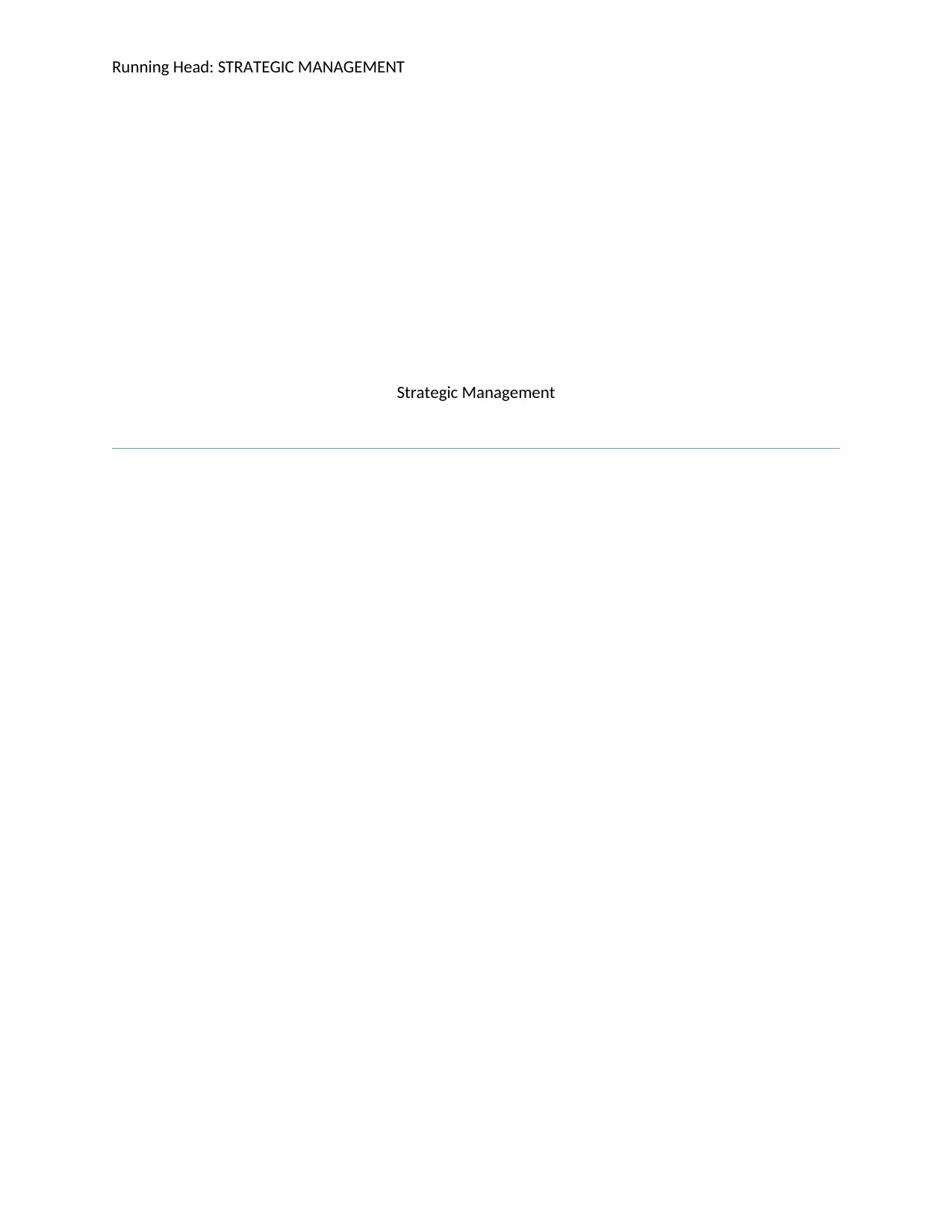
Running Head: STRATEGIC MANAGEMENT
Strategic Management
Strategic Management
Secure Best Marks with AI Grader
Need help grading? Try our AI Grader for instant feedback on your assignments.
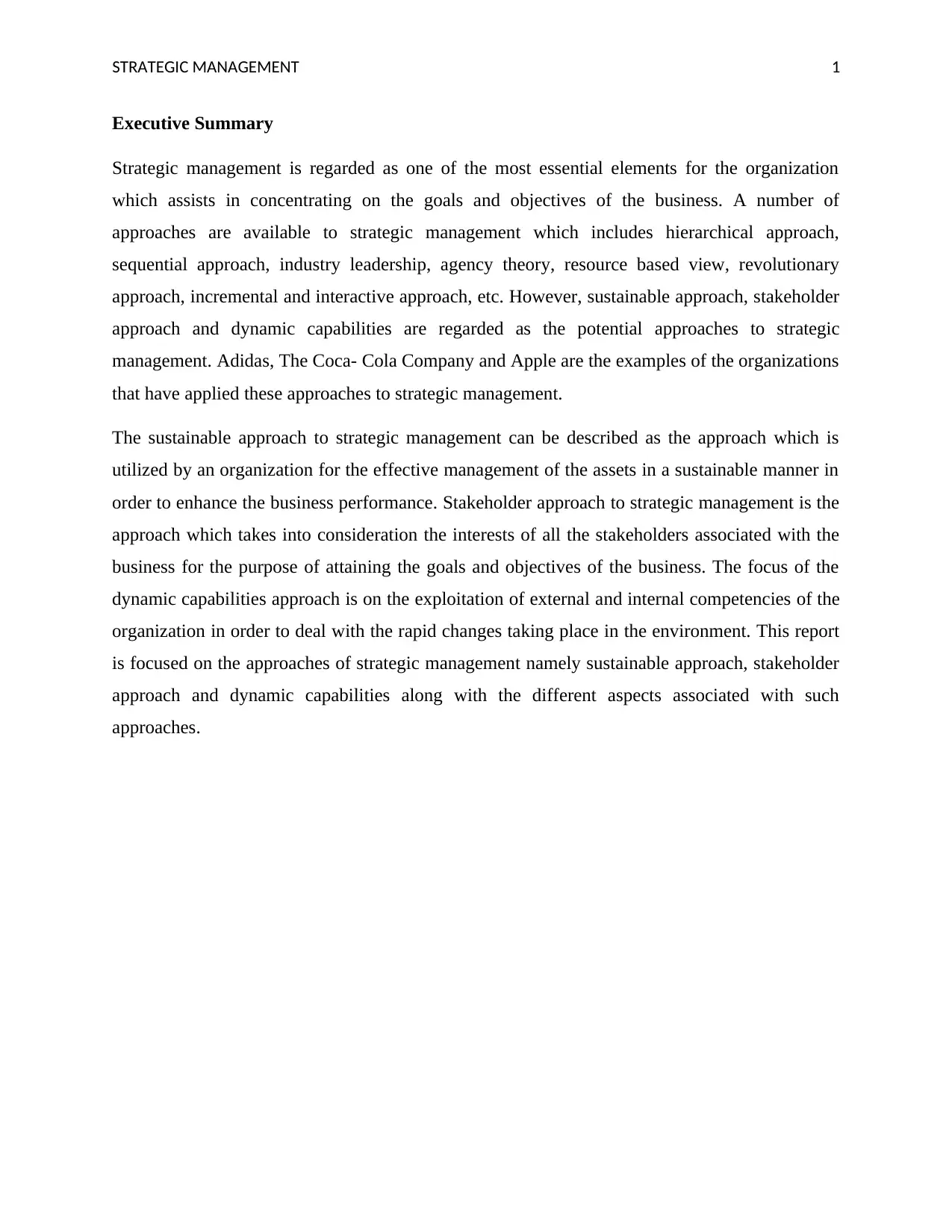
STRATEGIC MANAGEMENT 1
Executive Summary
Strategic management is regarded as one of the most essential elements for the organization
which assists in concentrating on the goals and objectives of the business. A number of
approaches are available to strategic management which includes hierarchical approach,
sequential approach, industry leadership, agency theory, resource based view, revolutionary
approach, incremental and interactive approach, etc. However, sustainable approach, stakeholder
approach and dynamic capabilities are regarded as the potential approaches to strategic
management. Adidas, The Coca- Cola Company and Apple are the examples of the organizations
that have applied these approaches to strategic management.
The sustainable approach to strategic management can be described as the approach which is
utilized by an organization for the effective management of the assets in a sustainable manner in
order to enhance the business performance. Stakeholder approach to strategic management is the
approach which takes into consideration the interests of all the stakeholders associated with the
business for the purpose of attaining the goals and objectives of the business. The focus of the
dynamic capabilities approach is on the exploitation of external and internal competencies of the
organization in order to deal with the rapid changes taking place in the environment. This report
is focused on the approaches of strategic management namely sustainable approach, stakeholder
approach and dynamic capabilities along with the different aspects associated with such
approaches.
Executive Summary
Strategic management is regarded as one of the most essential elements for the organization
which assists in concentrating on the goals and objectives of the business. A number of
approaches are available to strategic management which includes hierarchical approach,
sequential approach, industry leadership, agency theory, resource based view, revolutionary
approach, incremental and interactive approach, etc. However, sustainable approach, stakeholder
approach and dynamic capabilities are regarded as the potential approaches to strategic
management. Adidas, The Coca- Cola Company and Apple are the examples of the organizations
that have applied these approaches to strategic management.
The sustainable approach to strategic management can be described as the approach which is
utilized by an organization for the effective management of the assets in a sustainable manner in
order to enhance the business performance. Stakeholder approach to strategic management is the
approach which takes into consideration the interests of all the stakeholders associated with the
business for the purpose of attaining the goals and objectives of the business. The focus of the
dynamic capabilities approach is on the exploitation of external and internal competencies of the
organization in order to deal with the rapid changes taking place in the environment. This report
is focused on the approaches of strategic management namely sustainable approach, stakeholder
approach and dynamic capabilities along with the different aspects associated with such
approaches.
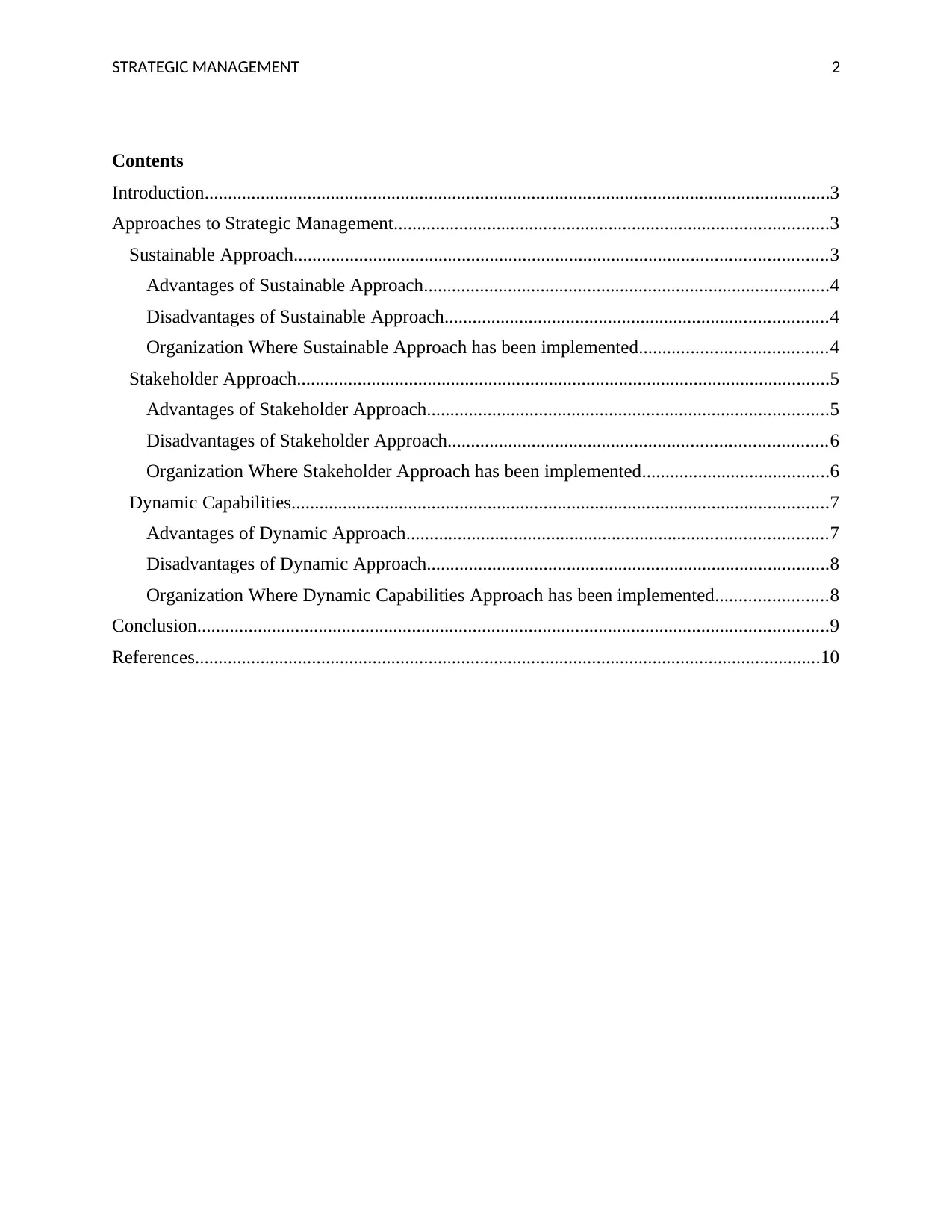
STRATEGIC MANAGEMENT 2
Contents
Introduction......................................................................................................................................3
Approaches to Strategic Management.............................................................................................3
Sustainable Approach..................................................................................................................3
Advantages of Sustainable Approach.......................................................................................4
Disadvantages of Sustainable Approach..................................................................................4
Organization Where Sustainable Approach has been implemented........................................4
Stakeholder Approach..................................................................................................................5
Advantages of Stakeholder Approach......................................................................................5
Disadvantages of Stakeholder Approach.................................................................................6
Organization Where Stakeholder Approach has been implemented........................................6
Dynamic Capabilities...................................................................................................................7
Advantages of Dynamic Approach..........................................................................................7
Disadvantages of Dynamic Approach......................................................................................8
Organization Where Dynamic Capabilities Approach has been implemented........................8
Conclusion.......................................................................................................................................9
References......................................................................................................................................10
Contents
Introduction......................................................................................................................................3
Approaches to Strategic Management.............................................................................................3
Sustainable Approach..................................................................................................................3
Advantages of Sustainable Approach.......................................................................................4
Disadvantages of Sustainable Approach..................................................................................4
Organization Where Sustainable Approach has been implemented........................................4
Stakeholder Approach..................................................................................................................5
Advantages of Stakeholder Approach......................................................................................5
Disadvantages of Stakeholder Approach.................................................................................6
Organization Where Stakeholder Approach has been implemented........................................6
Dynamic Capabilities...................................................................................................................7
Advantages of Dynamic Approach..........................................................................................7
Disadvantages of Dynamic Approach......................................................................................8
Organization Where Dynamic Capabilities Approach has been implemented........................8
Conclusion.......................................................................................................................................9
References......................................................................................................................................10
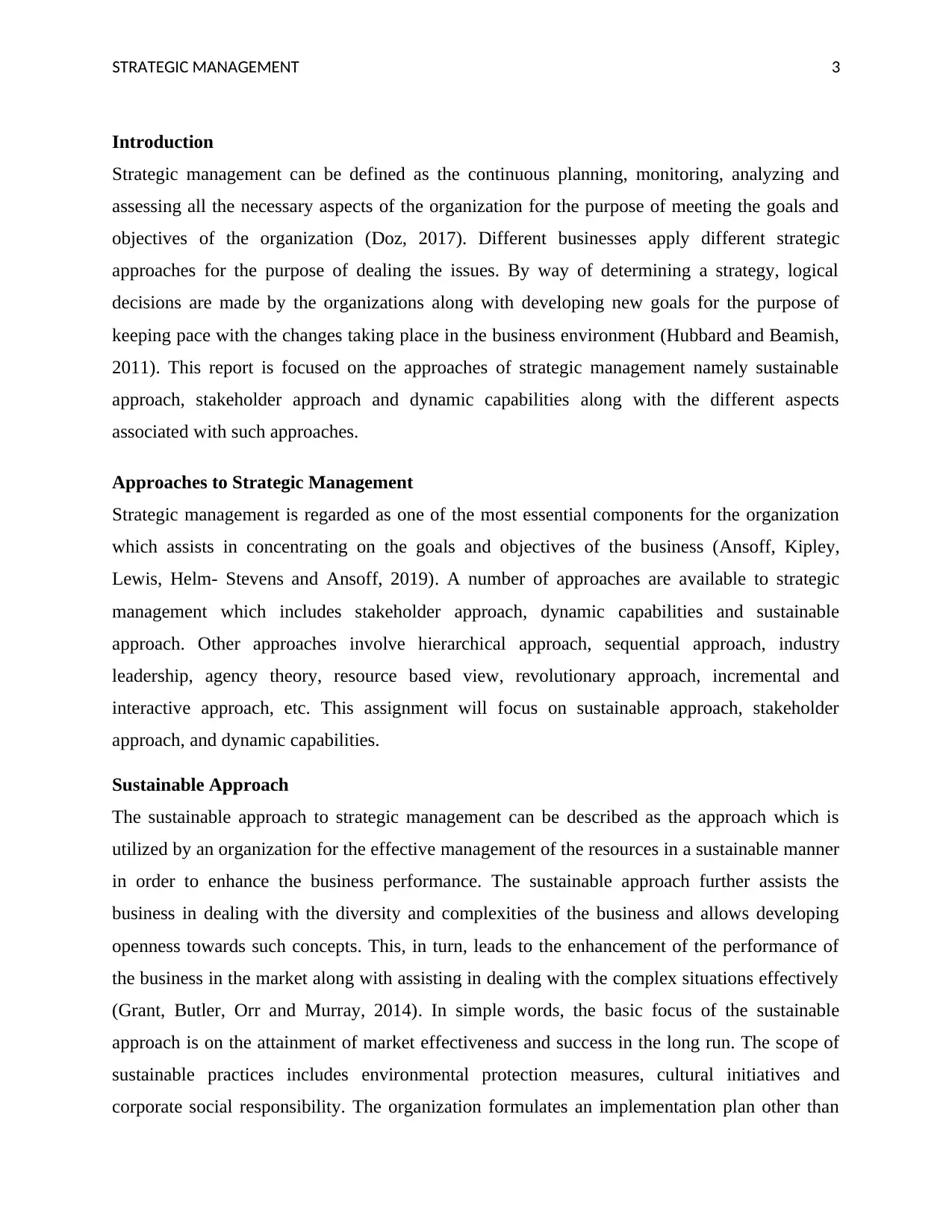
STRATEGIC MANAGEMENT 3
Introduction
Strategic management can be defined as the continuous planning, monitoring, analyzing and
assessing all the necessary aspects of the organization for the purpose of meeting the goals and
objectives of the organization (Doz, 2017). Different businesses apply different strategic
approaches for the purpose of dealing the issues. By way of determining a strategy, logical
decisions are made by the organizations along with developing new goals for the purpose of
keeping pace with the changes taking place in the business environment (Hubbard and Beamish,
2011). This report is focused on the approaches of strategic management namely sustainable
approach, stakeholder approach and dynamic capabilities along with the different aspects
associated with such approaches.
Approaches to Strategic Management
Strategic management is regarded as one of the most essential components for the organization
which assists in concentrating on the goals and objectives of the business (Ansoff, Kipley,
Lewis, Helm- Stevens and Ansoff, 2019). A number of approaches are available to strategic
management which includes stakeholder approach, dynamic capabilities and sustainable
approach. Other approaches involve hierarchical approach, sequential approach, industry
leadership, agency theory, resource based view, revolutionary approach, incremental and
interactive approach, etc. This assignment will focus on sustainable approach, stakeholder
approach, and dynamic capabilities.
Sustainable Approach
The sustainable approach to strategic management can be described as the approach which is
utilized by an organization for the effective management of the resources in a sustainable manner
in order to enhance the business performance. The sustainable approach further assists the
business in dealing with the diversity and complexities of the business and allows developing
openness towards such concepts. This, in turn, leads to the enhancement of the performance of
the business in the market along with assisting in dealing with the complex situations effectively
(Grant, Butler, Orr and Murray, 2014). In simple words, the basic focus of the sustainable
approach is on the attainment of market effectiveness and success in the long run. The scope of
sustainable practices includes environmental protection measures, cultural initiatives and
corporate social responsibility. The organization formulates an implementation plan other than
Introduction
Strategic management can be defined as the continuous planning, monitoring, analyzing and
assessing all the necessary aspects of the organization for the purpose of meeting the goals and
objectives of the organization (Doz, 2017). Different businesses apply different strategic
approaches for the purpose of dealing the issues. By way of determining a strategy, logical
decisions are made by the organizations along with developing new goals for the purpose of
keeping pace with the changes taking place in the business environment (Hubbard and Beamish,
2011). This report is focused on the approaches of strategic management namely sustainable
approach, stakeholder approach and dynamic capabilities along with the different aspects
associated with such approaches.
Approaches to Strategic Management
Strategic management is regarded as one of the most essential components for the organization
which assists in concentrating on the goals and objectives of the business (Ansoff, Kipley,
Lewis, Helm- Stevens and Ansoff, 2019). A number of approaches are available to strategic
management which includes stakeholder approach, dynamic capabilities and sustainable
approach. Other approaches involve hierarchical approach, sequential approach, industry
leadership, agency theory, resource based view, revolutionary approach, incremental and
interactive approach, etc. This assignment will focus on sustainable approach, stakeholder
approach, and dynamic capabilities.
Sustainable Approach
The sustainable approach to strategic management can be described as the approach which is
utilized by an organization for the effective management of the resources in a sustainable manner
in order to enhance the business performance. The sustainable approach further assists the
business in dealing with the diversity and complexities of the business and allows developing
openness towards such concepts. This, in turn, leads to the enhancement of the performance of
the business in the market along with assisting in dealing with the complex situations effectively
(Grant, Butler, Orr and Murray, 2014). In simple words, the basic focus of the sustainable
approach is on the attainment of market effectiveness and success in the long run. The scope of
sustainable practices includes environmental protection measures, cultural initiatives and
corporate social responsibility. The organization formulates an implementation plan other than
Secure Best Marks with AI Grader
Need help grading? Try our AI Grader for instant feedback on your assignments.
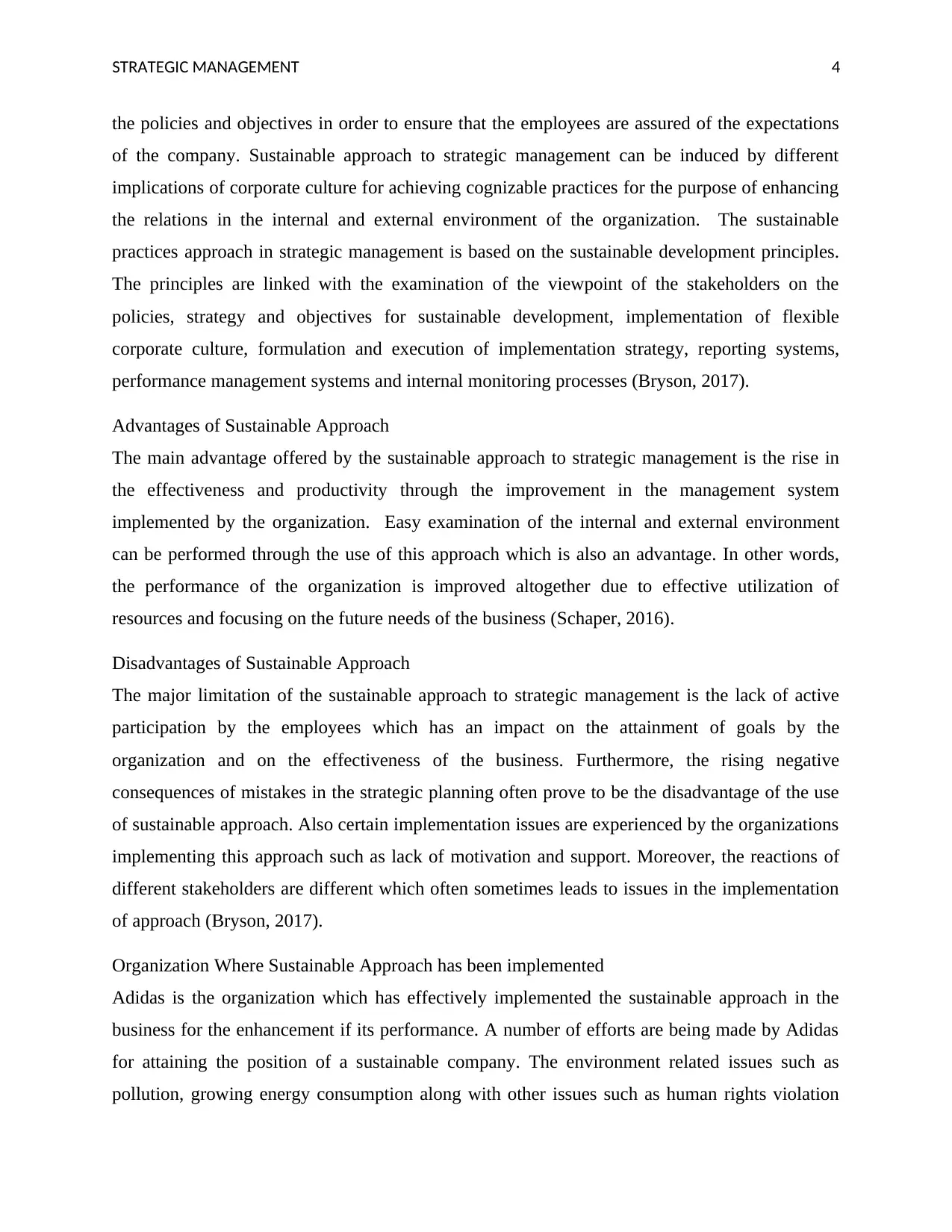
STRATEGIC MANAGEMENT 4
the policies and objectives in order to ensure that the employees are assured of the expectations
of the company. Sustainable approach to strategic management can be induced by different
implications of corporate culture for achieving cognizable practices for the purpose of enhancing
the relations in the internal and external environment of the organization. The sustainable
practices approach in strategic management is based on the sustainable development principles.
The principles are linked with the examination of the viewpoint of the stakeholders on the
policies, strategy and objectives for sustainable development, implementation of flexible
corporate culture, formulation and execution of implementation strategy, reporting systems,
performance management systems and internal monitoring processes (Bryson, 2017).
Advantages of Sustainable Approach
The main advantage offered by the sustainable approach to strategic management is the rise in
the effectiveness and productivity through the improvement in the management system
implemented by the organization. Easy examination of the internal and external environment
can be performed through the use of this approach which is also an advantage. In other words,
the performance of the organization is improved altogether due to effective utilization of
resources and focusing on the future needs of the business (Schaper, 2016).
Disadvantages of Sustainable Approach
The major limitation of the sustainable approach to strategic management is the lack of active
participation by the employees which has an impact on the attainment of goals by the
organization and on the effectiveness of the business. Furthermore, the rising negative
consequences of mistakes in the strategic planning often prove to be the disadvantage of the use
of sustainable approach. Also certain implementation issues are experienced by the organizations
implementing this approach such as lack of motivation and support. Moreover, the reactions of
different stakeholders are different which often sometimes leads to issues in the implementation
of approach (Bryson, 2017).
Organization Where Sustainable Approach has been implemented
Adidas is the organization which has effectively implemented the sustainable approach in the
business for the enhancement if its performance. A number of efforts are being made by Adidas
for attaining the position of a sustainable company. The environment related issues such as
pollution, growing energy consumption along with other issues such as human rights violation
the policies and objectives in order to ensure that the employees are assured of the expectations
of the company. Sustainable approach to strategic management can be induced by different
implications of corporate culture for achieving cognizable practices for the purpose of enhancing
the relations in the internal and external environment of the organization. The sustainable
practices approach in strategic management is based on the sustainable development principles.
The principles are linked with the examination of the viewpoint of the stakeholders on the
policies, strategy and objectives for sustainable development, implementation of flexible
corporate culture, formulation and execution of implementation strategy, reporting systems,
performance management systems and internal monitoring processes (Bryson, 2017).
Advantages of Sustainable Approach
The main advantage offered by the sustainable approach to strategic management is the rise in
the effectiveness and productivity through the improvement in the management system
implemented by the organization. Easy examination of the internal and external environment
can be performed through the use of this approach which is also an advantage. In other words,
the performance of the organization is improved altogether due to effective utilization of
resources and focusing on the future needs of the business (Schaper, 2016).
Disadvantages of Sustainable Approach
The major limitation of the sustainable approach to strategic management is the lack of active
participation by the employees which has an impact on the attainment of goals by the
organization and on the effectiveness of the business. Furthermore, the rising negative
consequences of mistakes in the strategic planning often prove to be the disadvantage of the use
of sustainable approach. Also certain implementation issues are experienced by the organizations
implementing this approach such as lack of motivation and support. Moreover, the reactions of
different stakeholders are different which often sometimes leads to issues in the implementation
of approach (Bryson, 2017).
Organization Where Sustainable Approach has been implemented
Adidas is the organization which has effectively implemented the sustainable approach in the
business for the enhancement if its performance. A number of efforts are being made by Adidas
for attaining the position of a sustainable company. The environment related issues such as
pollution, growing energy consumption along with other issues such as human rights violation
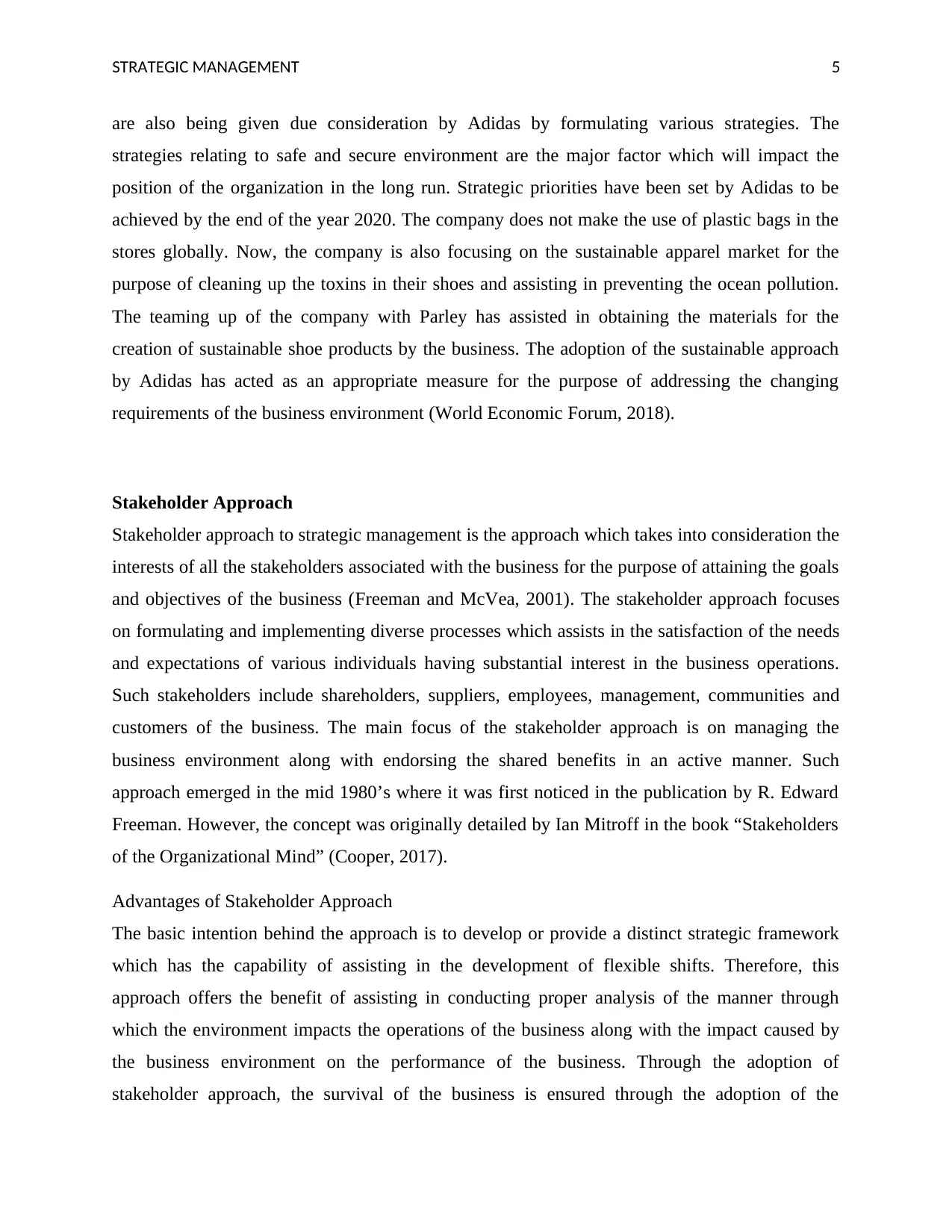
STRATEGIC MANAGEMENT 5
are also being given due consideration by Adidas by formulating various strategies. The
strategies relating to safe and secure environment are the major factor which will impact the
position of the organization in the long run. Strategic priorities have been set by Adidas to be
achieved by the end of the year 2020. The company does not make the use of plastic bags in the
stores globally. Now, the company is also focusing on the sustainable apparel market for the
purpose of cleaning up the toxins in their shoes and assisting in preventing the ocean pollution.
The teaming up of the company with Parley has assisted in obtaining the materials for the
creation of sustainable shoe products by the business. The adoption of the sustainable approach
by Adidas has acted as an appropriate measure for the purpose of addressing the changing
requirements of the business environment (World Economic Forum, 2018).
Stakeholder Approach
Stakeholder approach to strategic management is the approach which takes into consideration the
interests of all the stakeholders associated with the business for the purpose of attaining the goals
and objectives of the business (Freeman and McVea, 2001). The stakeholder approach focuses
on formulating and implementing diverse processes which assists in the satisfaction of the needs
and expectations of various individuals having substantial interest in the business operations.
Such stakeholders include shareholders, suppliers, employees, management, communities and
customers of the business. The main focus of the stakeholder approach is on managing the
business environment along with endorsing the shared benefits in an active manner. Such
approach emerged in the mid 1980’s where it was first noticed in the publication by R. Edward
Freeman. However, the concept was originally detailed by Ian Mitroff in the book “Stakeholders
of the Organizational Mind” (Cooper, 2017).
Advantages of Stakeholder Approach
The basic intention behind the approach is to develop or provide a distinct strategic framework
which has the capability of assisting in the development of flexible shifts. Therefore, this
approach offers the benefit of assisting in conducting proper analysis of the manner through
which the environment impacts the operations of the business along with the impact caused by
the business environment on the performance of the business. Through the adoption of
stakeholder approach, the survival of the business is ensured through the adoption of the
are also being given due consideration by Adidas by formulating various strategies. The
strategies relating to safe and secure environment are the major factor which will impact the
position of the organization in the long run. Strategic priorities have been set by Adidas to be
achieved by the end of the year 2020. The company does not make the use of plastic bags in the
stores globally. Now, the company is also focusing on the sustainable apparel market for the
purpose of cleaning up the toxins in their shoes and assisting in preventing the ocean pollution.
The teaming up of the company with Parley has assisted in obtaining the materials for the
creation of sustainable shoe products by the business. The adoption of the sustainable approach
by Adidas has acted as an appropriate measure for the purpose of addressing the changing
requirements of the business environment (World Economic Forum, 2018).
Stakeholder Approach
Stakeholder approach to strategic management is the approach which takes into consideration the
interests of all the stakeholders associated with the business for the purpose of attaining the goals
and objectives of the business (Freeman and McVea, 2001). The stakeholder approach focuses
on formulating and implementing diverse processes which assists in the satisfaction of the needs
and expectations of various individuals having substantial interest in the business operations.
Such stakeholders include shareholders, suppliers, employees, management, communities and
customers of the business. The main focus of the stakeholder approach is on managing the
business environment along with endorsing the shared benefits in an active manner. Such
approach emerged in the mid 1980’s where it was first noticed in the publication by R. Edward
Freeman. However, the concept was originally detailed by Ian Mitroff in the book “Stakeholders
of the Organizational Mind” (Cooper, 2017).
Advantages of Stakeholder Approach
The basic intention behind the approach is to develop or provide a distinct strategic framework
which has the capability of assisting in the development of flexible shifts. Therefore, this
approach offers the benefit of assisting in conducting proper analysis of the manner through
which the environment impacts the operations of the business along with the impact caused by
the business environment on the performance of the business. Through the adoption of
stakeholder approach, the survival of the business is ensured through the adoption of the
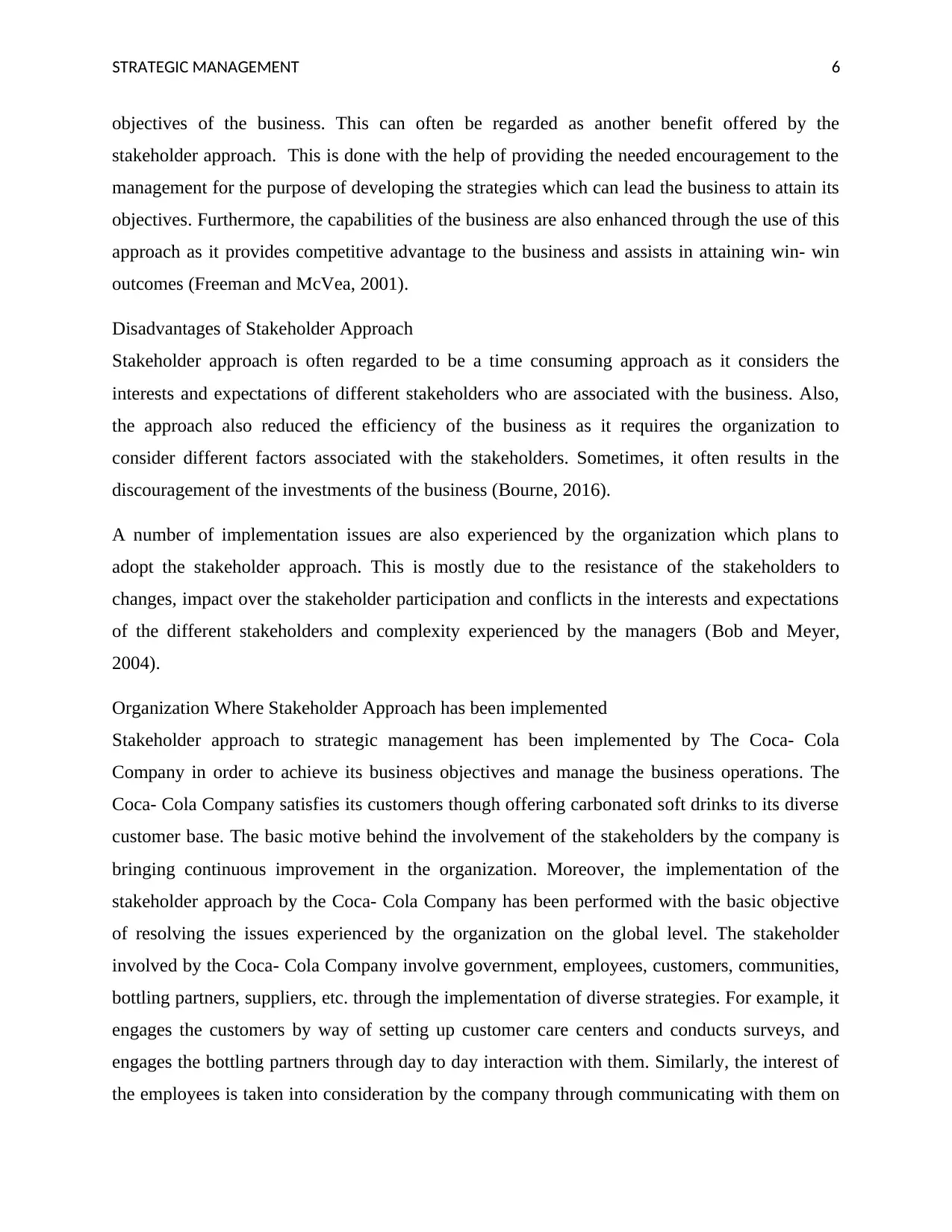
STRATEGIC MANAGEMENT 6
objectives of the business. This can often be regarded as another benefit offered by the
stakeholder approach. This is done with the help of providing the needed encouragement to the
management for the purpose of developing the strategies which can lead the business to attain its
objectives. Furthermore, the capabilities of the business are also enhanced through the use of this
approach as it provides competitive advantage to the business and assists in attaining win- win
outcomes (Freeman and McVea, 2001).
Disadvantages of Stakeholder Approach
Stakeholder approach is often regarded to be a time consuming approach as it considers the
interests and expectations of different stakeholders who are associated with the business. Also,
the approach also reduced the efficiency of the business as it requires the organization to
consider different factors associated with the stakeholders. Sometimes, it often results in the
discouragement of the investments of the business (Bourne, 2016).
A number of implementation issues are also experienced by the organization which plans to
adopt the stakeholder approach. This is mostly due to the resistance of the stakeholders to
changes, impact over the stakeholder participation and conflicts in the interests and expectations
of the different stakeholders and complexity experienced by the managers (Bob and Meyer,
2004).
Organization Where Stakeholder Approach has been implemented
Stakeholder approach to strategic management has been implemented by The Coca- Cola
Company in order to achieve its business objectives and manage the business operations. The
Coca- Cola Company satisfies its customers though offering carbonated soft drinks to its diverse
customer base. The basic motive behind the involvement of the stakeholders by the company is
bringing continuous improvement in the organization. Moreover, the implementation of the
stakeholder approach by the Coca- Cola Company has been performed with the basic objective
of resolving the issues experienced by the organization on the global level. The stakeholder
involved by the Coca- Cola Company involve government, employees, customers, communities,
bottling partners, suppliers, etc. through the implementation of diverse strategies. For example, it
engages the customers by way of setting up customer care centers and conducts surveys, and
engages the bottling partners through day to day interaction with them. Similarly, the interest of
the employees is taken into consideration by the company through communicating with them on
objectives of the business. This can often be regarded as another benefit offered by the
stakeholder approach. This is done with the help of providing the needed encouragement to the
management for the purpose of developing the strategies which can lead the business to attain its
objectives. Furthermore, the capabilities of the business are also enhanced through the use of this
approach as it provides competitive advantage to the business and assists in attaining win- win
outcomes (Freeman and McVea, 2001).
Disadvantages of Stakeholder Approach
Stakeholder approach is often regarded to be a time consuming approach as it considers the
interests and expectations of different stakeholders who are associated with the business. Also,
the approach also reduced the efficiency of the business as it requires the organization to
consider different factors associated with the stakeholders. Sometimes, it often results in the
discouragement of the investments of the business (Bourne, 2016).
A number of implementation issues are also experienced by the organization which plans to
adopt the stakeholder approach. This is mostly due to the resistance of the stakeholders to
changes, impact over the stakeholder participation and conflicts in the interests and expectations
of the different stakeholders and complexity experienced by the managers (Bob and Meyer,
2004).
Organization Where Stakeholder Approach has been implemented
Stakeholder approach to strategic management has been implemented by The Coca- Cola
Company in order to achieve its business objectives and manage the business operations. The
Coca- Cola Company satisfies its customers though offering carbonated soft drinks to its diverse
customer base. The basic motive behind the involvement of the stakeholders by the company is
bringing continuous improvement in the organization. Moreover, the implementation of the
stakeholder approach by the Coca- Cola Company has been performed with the basic objective
of resolving the issues experienced by the organization on the global level. The stakeholder
involved by the Coca- Cola Company involve government, employees, customers, communities,
bottling partners, suppliers, etc. through the implementation of diverse strategies. For example, it
engages the customers by way of setting up customer care centers and conducts surveys, and
engages the bottling partners through day to day interaction with them. Similarly, the interest of
the employees is taken into consideration by the company through communicating with them on
Paraphrase This Document
Need a fresh take? Get an instant paraphrase of this document with our AI Paraphraser
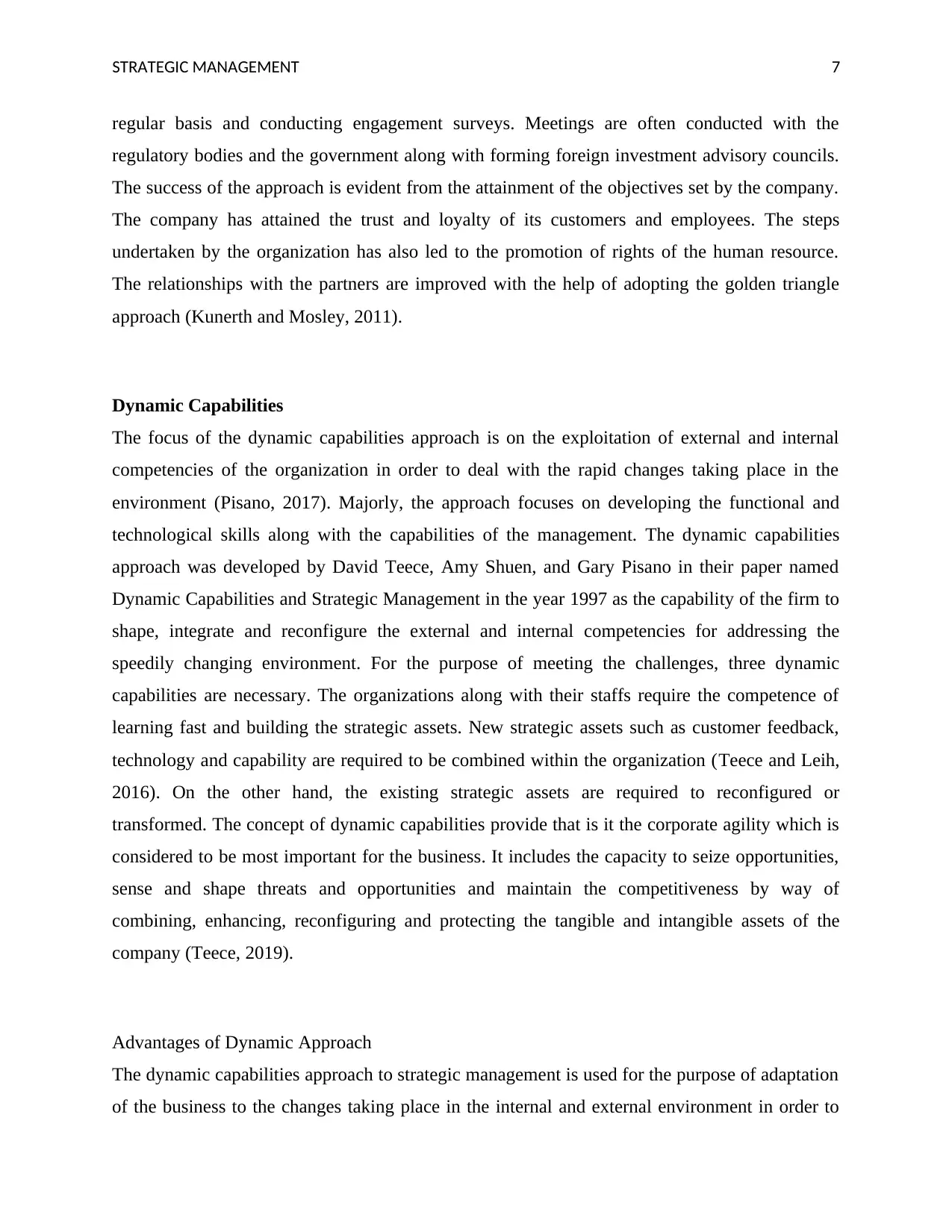
STRATEGIC MANAGEMENT 7
regular basis and conducting engagement surveys. Meetings are often conducted with the
regulatory bodies and the government along with forming foreign investment advisory councils.
The success of the approach is evident from the attainment of the objectives set by the company.
The company has attained the trust and loyalty of its customers and employees. The steps
undertaken by the organization has also led to the promotion of rights of the human resource.
The relationships with the partners are improved with the help of adopting the golden triangle
approach (Kunerth and Mosley, 2011).
Dynamic Capabilities
The focus of the dynamic capabilities approach is on the exploitation of external and internal
competencies of the organization in order to deal with the rapid changes taking place in the
environment (Pisano, 2017). Majorly, the approach focuses on developing the functional and
technological skills along with the capabilities of the management. The dynamic capabilities
approach was developed by David Teece, Amy Shuen, and Gary Pisano in their paper named
Dynamic Capabilities and Strategic Management in the year 1997 as the capability of the firm to
shape, integrate and reconfigure the external and internal competencies for addressing the
speedily changing environment. For the purpose of meeting the challenges, three dynamic
capabilities are necessary. The organizations along with their staffs require the competence of
learning fast and building the strategic assets. New strategic assets such as customer feedback,
technology and capability are required to be combined within the organization (Teece and Leih,
2016). On the other hand, the existing strategic assets are required to reconfigured or
transformed. The concept of dynamic capabilities provide that is it the corporate agility which is
considered to be most important for the business. It includes the capacity to seize opportunities,
sense and shape threats and opportunities and maintain the competitiveness by way of
combining, enhancing, reconfiguring and protecting the tangible and intangible assets of the
company (Teece, 2019).
Advantages of Dynamic Approach
The dynamic capabilities approach to strategic management is used for the purpose of adaptation
of the business to the changes taking place in the internal and external environment in order to
regular basis and conducting engagement surveys. Meetings are often conducted with the
regulatory bodies and the government along with forming foreign investment advisory councils.
The success of the approach is evident from the attainment of the objectives set by the company.
The company has attained the trust and loyalty of its customers and employees. The steps
undertaken by the organization has also led to the promotion of rights of the human resource.
The relationships with the partners are improved with the help of adopting the golden triangle
approach (Kunerth and Mosley, 2011).
Dynamic Capabilities
The focus of the dynamic capabilities approach is on the exploitation of external and internal
competencies of the organization in order to deal with the rapid changes taking place in the
environment (Pisano, 2017). Majorly, the approach focuses on developing the functional and
technological skills along with the capabilities of the management. The dynamic capabilities
approach was developed by David Teece, Amy Shuen, and Gary Pisano in their paper named
Dynamic Capabilities and Strategic Management in the year 1997 as the capability of the firm to
shape, integrate and reconfigure the external and internal competencies for addressing the
speedily changing environment. For the purpose of meeting the challenges, three dynamic
capabilities are necessary. The organizations along with their staffs require the competence of
learning fast and building the strategic assets. New strategic assets such as customer feedback,
technology and capability are required to be combined within the organization (Teece and Leih,
2016). On the other hand, the existing strategic assets are required to reconfigured or
transformed. The concept of dynamic capabilities provide that is it the corporate agility which is
considered to be most important for the business. It includes the capacity to seize opportunities,
sense and shape threats and opportunities and maintain the competitiveness by way of
combining, enhancing, reconfiguring and protecting the tangible and intangible assets of the
company (Teece, 2019).
Advantages of Dynamic Approach
The dynamic capabilities approach to strategic management is used for the purpose of adaptation
of the business to the changes taking place in the internal and external environment in order to
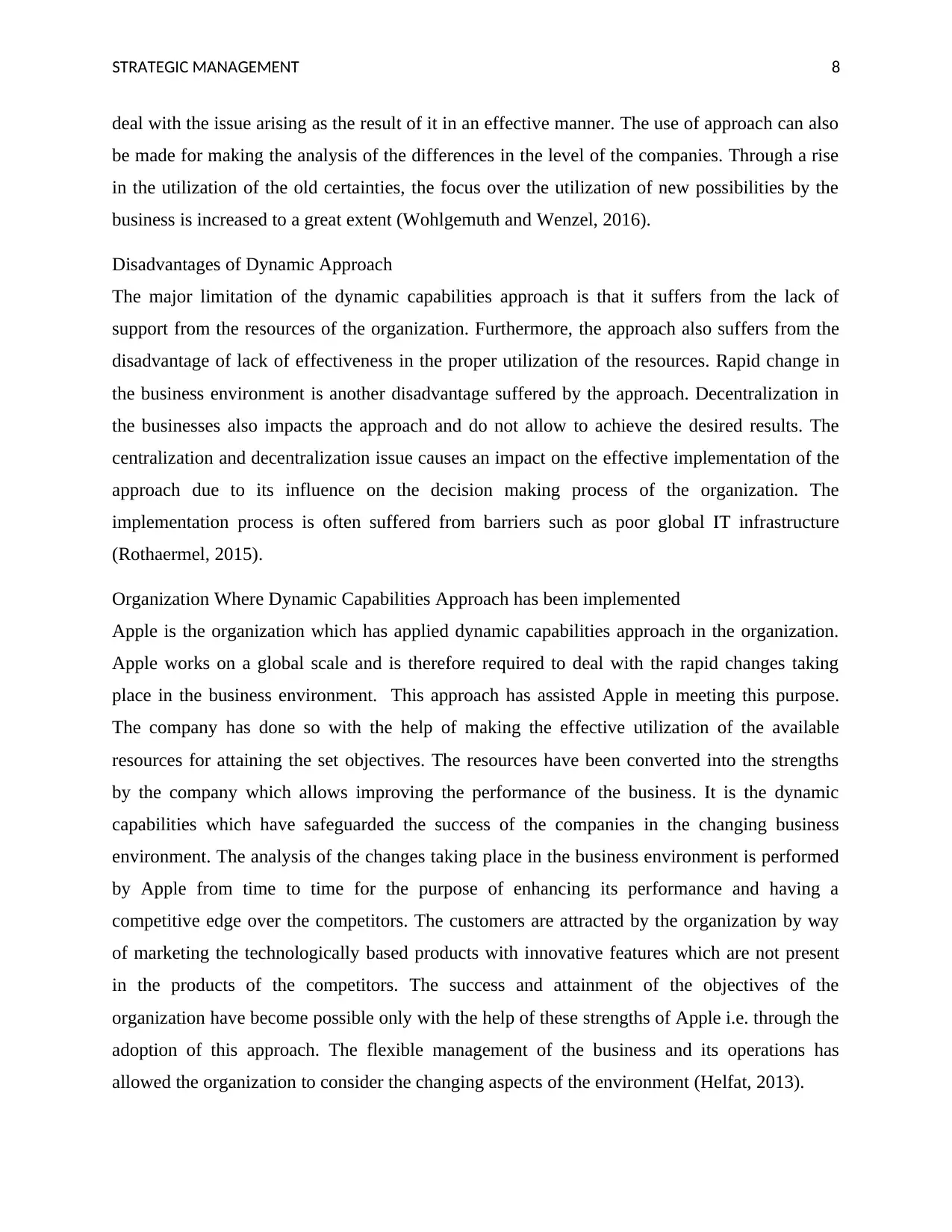
STRATEGIC MANAGEMENT 8
deal with the issue arising as the result of it in an effective manner. The use of approach can also
be made for making the analysis of the differences in the level of the companies. Through a rise
in the utilization of the old certainties, the focus over the utilization of new possibilities by the
business is increased to a great extent (Wohlgemuth and Wenzel, 2016).
Disadvantages of Dynamic Approach
The major limitation of the dynamic capabilities approach is that it suffers from the lack of
support from the resources of the organization. Furthermore, the approach also suffers from the
disadvantage of lack of effectiveness in the proper utilization of the resources. Rapid change in
the business environment is another disadvantage suffered by the approach. Decentralization in
the businesses also impacts the approach and do not allow to achieve the desired results. The
centralization and decentralization issue causes an impact on the effective implementation of the
approach due to its influence on the decision making process of the organization. The
implementation process is often suffered from barriers such as poor global IT infrastructure
(Rothaermel, 2015).
Organization Where Dynamic Capabilities Approach has been implemented
Apple is the organization which has applied dynamic capabilities approach in the organization.
Apple works on a global scale and is therefore required to deal with the rapid changes taking
place in the business environment. This approach has assisted Apple in meeting this purpose.
The company has done so with the help of making the effective utilization of the available
resources for attaining the set objectives. The resources have been converted into the strengths
by the company which allows improving the performance of the business. It is the dynamic
capabilities which have safeguarded the success of the companies in the changing business
environment. The analysis of the changes taking place in the business environment is performed
by Apple from time to time for the purpose of enhancing its performance and having a
competitive edge over the competitors. The customers are attracted by the organization by way
of marketing the technologically based products with innovative features which are not present
in the products of the competitors. The success and attainment of the objectives of the
organization have become possible only with the help of these strengths of Apple i.e. through the
adoption of this approach. The flexible management of the business and its operations has
allowed the organization to consider the changing aspects of the environment (Helfat, 2013).
deal with the issue arising as the result of it in an effective manner. The use of approach can also
be made for making the analysis of the differences in the level of the companies. Through a rise
in the utilization of the old certainties, the focus over the utilization of new possibilities by the
business is increased to a great extent (Wohlgemuth and Wenzel, 2016).
Disadvantages of Dynamic Approach
The major limitation of the dynamic capabilities approach is that it suffers from the lack of
support from the resources of the organization. Furthermore, the approach also suffers from the
disadvantage of lack of effectiveness in the proper utilization of the resources. Rapid change in
the business environment is another disadvantage suffered by the approach. Decentralization in
the businesses also impacts the approach and do not allow to achieve the desired results. The
centralization and decentralization issue causes an impact on the effective implementation of the
approach due to its influence on the decision making process of the organization. The
implementation process is often suffered from barriers such as poor global IT infrastructure
(Rothaermel, 2015).
Organization Where Dynamic Capabilities Approach has been implemented
Apple is the organization which has applied dynamic capabilities approach in the organization.
Apple works on a global scale and is therefore required to deal with the rapid changes taking
place in the business environment. This approach has assisted Apple in meeting this purpose.
The company has done so with the help of making the effective utilization of the available
resources for attaining the set objectives. The resources have been converted into the strengths
by the company which allows improving the performance of the business. It is the dynamic
capabilities which have safeguarded the success of the companies in the changing business
environment. The analysis of the changes taking place in the business environment is performed
by Apple from time to time for the purpose of enhancing its performance and having a
competitive edge over the competitors. The customers are attracted by the organization by way
of marketing the technologically based products with innovative features which are not present
in the products of the competitors. The success and attainment of the objectives of the
organization have become possible only with the help of these strengths of Apple i.e. through the
adoption of this approach. The flexible management of the business and its operations has
allowed the organization to consider the changing aspects of the environment (Helfat, 2013).
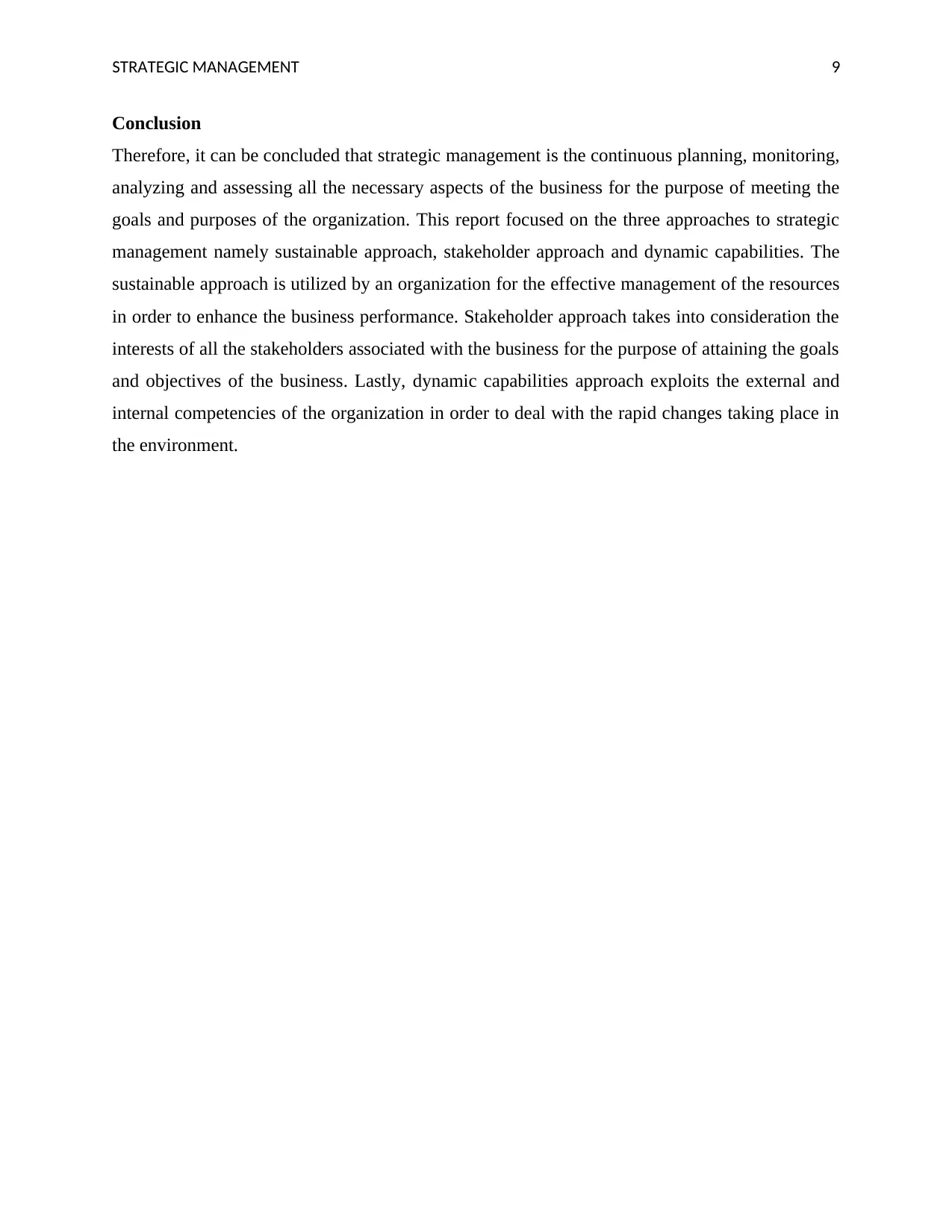
STRATEGIC MANAGEMENT 9
Conclusion
Therefore, it can be concluded that strategic management is the continuous planning, monitoring,
analyzing and assessing all the necessary aspects of the business for the purpose of meeting the
goals and purposes of the organization. This report focused on the three approaches to strategic
management namely sustainable approach, stakeholder approach and dynamic capabilities. The
sustainable approach is utilized by an organization for the effective management of the resources
in order to enhance the business performance. Stakeholder approach takes into consideration the
interests of all the stakeholders associated with the business for the purpose of attaining the goals
and objectives of the business. Lastly, dynamic capabilities approach exploits the external and
internal competencies of the organization in order to deal with the rapid changes taking place in
the environment.
Conclusion
Therefore, it can be concluded that strategic management is the continuous planning, monitoring,
analyzing and assessing all the necessary aspects of the business for the purpose of meeting the
goals and purposes of the organization. This report focused on the three approaches to strategic
management namely sustainable approach, stakeholder approach and dynamic capabilities. The
sustainable approach is utilized by an organization for the effective management of the resources
in order to enhance the business performance. Stakeholder approach takes into consideration the
interests of all the stakeholders associated with the business for the purpose of attaining the goals
and objectives of the business. Lastly, dynamic capabilities approach exploits the external and
internal competencies of the organization in order to deal with the rapid changes taking place in
the environment.
Secure Best Marks with AI Grader
Need help grading? Try our AI Grader for instant feedback on your assignments.
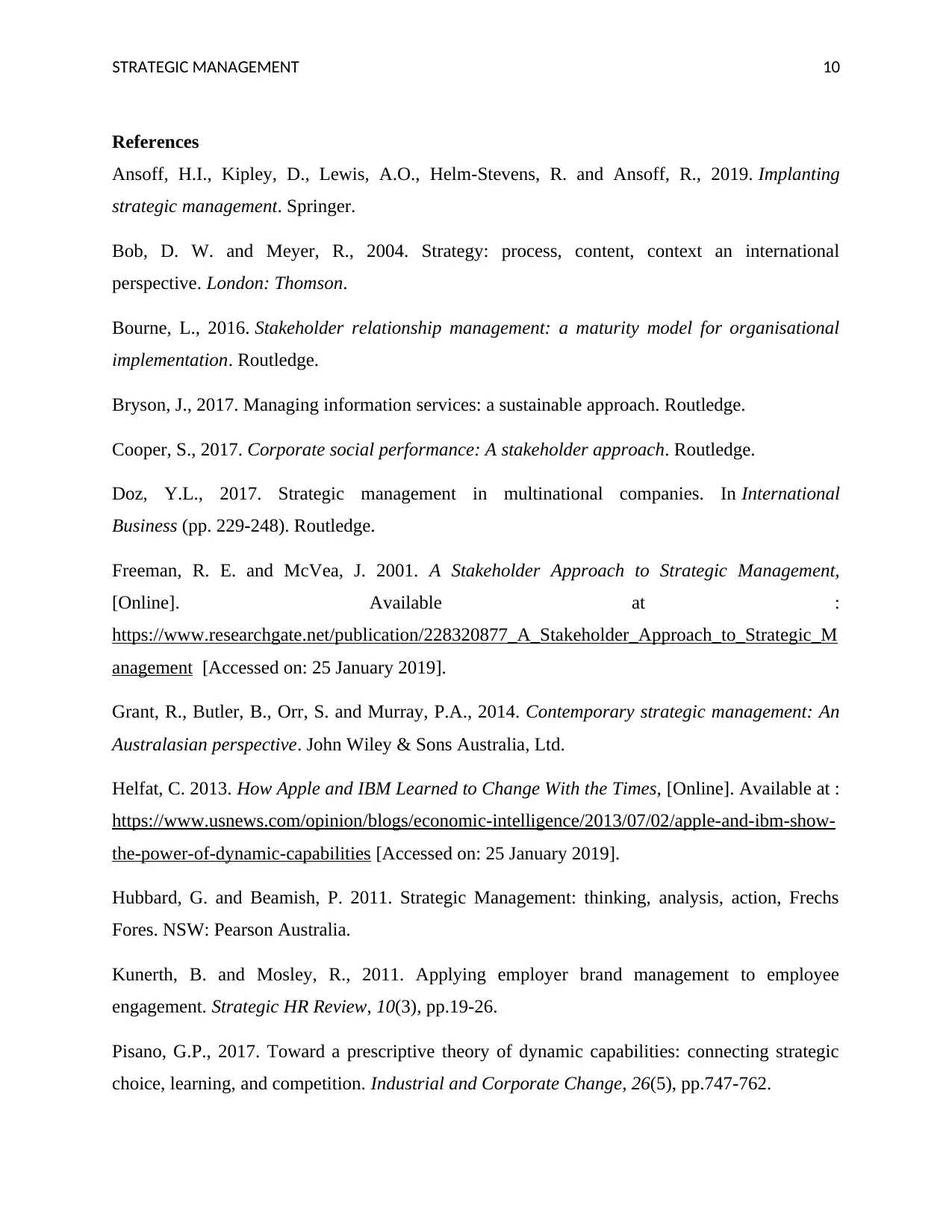
STRATEGIC MANAGEMENT 10
References
Ansoff, H.I., Kipley, D., Lewis, A.O., Helm-Stevens, R. and Ansoff, R., 2019. Implanting
strategic management. Springer.
Bob, D. W. and Meyer, R., 2004. Strategy: process, content, context an international
perspective. London: Thomson.
Bourne, L., 2016. Stakeholder relationship management: a maturity model for organisational
implementation. Routledge.
Bryson, J., 2017. Managing information services: a sustainable approach. Routledge.
Cooper, S., 2017. Corporate social performance: A stakeholder approach. Routledge.
Doz, Y.L., 2017. Strategic management in multinational companies. In International
Business (pp. 229-248). Routledge.
Freeman, R. E. and McVea, J. 2001. A Stakeholder Approach to Strategic Management,
[Online]. Available at :
https://www.researchgate.net/publication/228320877_A_Stakeholder_Approach_to_Strategic_M
anagement [Accessed on: 25 January 2019].
Grant, R., Butler, B., Orr, S. and Murray, P.A., 2014. Contemporary strategic management: An
Australasian perspective. John Wiley & Sons Australia, Ltd.
Helfat, C. 2013. How Apple and IBM Learned to Change With the Times, [Online]. Available at :
https://www.usnews.com/opinion/blogs/economic-intelligence/2013/07/02/apple-and-ibm-show-
the-power-of-dynamic-capabilities [Accessed on: 25 January 2019].
Hubbard, G. and Beamish, P. 2011. Strategic Management: thinking, analysis, action, Frechs
Fores. NSW: Pearson Australia.
Kunerth, B. and Mosley, R., 2011. Applying employer brand management to employee
engagement. Strategic HR Review, 10(3), pp.19-26.
Pisano, G.P., 2017. Toward a prescriptive theory of dynamic capabilities: connecting strategic
choice, learning, and competition. Industrial and Corporate Change, 26(5), pp.747-762.
References
Ansoff, H.I., Kipley, D., Lewis, A.O., Helm-Stevens, R. and Ansoff, R., 2019. Implanting
strategic management. Springer.
Bob, D. W. and Meyer, R., 2004. Strategy: process, content, context an international
perspective. London: Thomson.
Bourne, L., 2016. Stakeholder relationship management: a maturity model for organisational
implementation. Routledge.
Bryson, J., 2017. Managing information services: a sustainable approach. Routledge.
Cooper, S., 2017. Corporate social performance: A stakeholder approach. Routledge.
Doz, Y.L., 2017. Strategic management in multinational companies. In International
Business (pp. 229-248). Routledge.
Freeman, R. E. and McVea, J. 2001. A Stakeholder Approach to Strategic Management,
[Online]. Available at :
https://www.researchgate.net/publication/228320877_A_Stakeholder_Approach_to_Strategic_M
anagement [Accessed on: 25 January 2019].
Grant, R., Butler, B., Orr, S. and Murray, P.A., 2014. Contemporary strategic management: An
Australasian perspective. John Wiley & Sons Australia, Ltd.
Helfat, C. 2013. How Apple and IBM Learned to Change With the Times, [Online]. Available at :
https://www.usnews.com/opinion/blogs/economic-intelligence/2013/07/02/apple-and-ibm-show-
the-power-of-dynamic-capabilities [Accessed on: 25 January 2019].
Hubbard, G. and Beamish, P. 2011. Strategic Management: thinking, analysis, action, Frechs
Fores. NSW: Pearson Australia.
Kunerth, B. and Mosley, R., 2011. Applying employer brand management to employee
engagement. Strategic HR Review, 10(3), pp.19-26.
Pisano, G.P., 2017. Toward a prescriptive theory of dynamic capabilities: connecting strategic
choice, learning, and competition. Industrial and Corporate Change, 26(5), pp.747-762.
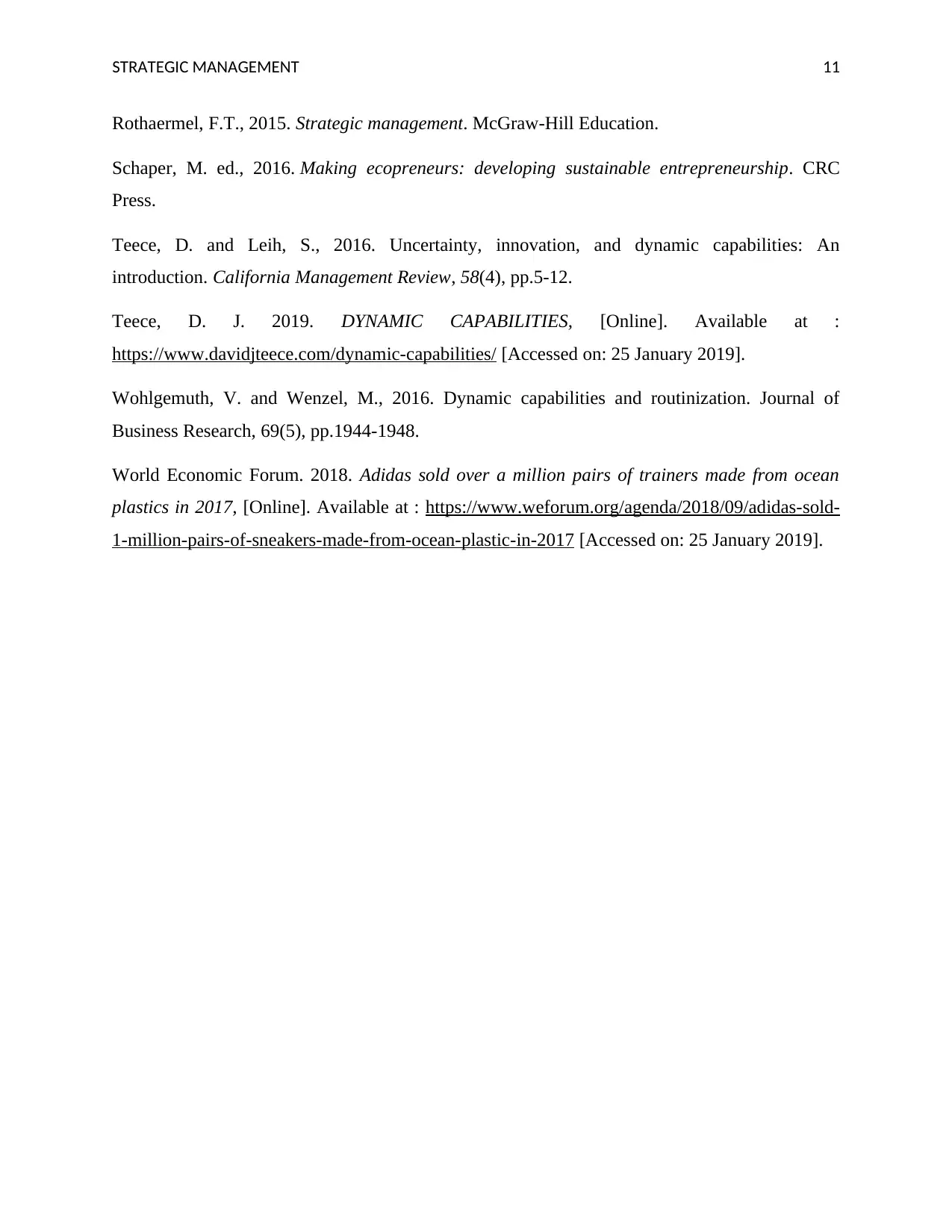
STRATEGIC MANAGEMENT 11
Rothaermel, F.T., 2015. Strategic management. McGraw-Hill Education.
Schaper, M. ed., 2016. Making ecopreneurs: developing sustainable entrepreneurship. CRC
Press.
Teece, D. and Leih, S., 2016. Uncertainty, innovation, and dynamic capabilities: An
introduction. California Management Review, 58(4), pp.5-12.
Teece, D. J. 2019. DYNAMIC CAPABILITIES, [Online]. Available at :
https://www.davidjteece.com/dynamic-capabilities/ [Accessed on: 25 January 2019].
Wohlgemuth, V. and Wenzel, M., 2016. Dynamic capabilities and routinization. Journal of
Business Research, 69(5), pp.1944-1948.
World Economic Forum. 2018. Adidas sold over a million pairs of trainers made from ocean
plastics in 2017, [Online]. Available at : https://www.weforum.org/agenda/2018/09/adidas-sold-
1-million-pairs-of-sneakers-made-from-ocean-plastic-in-2017 [Accessed on: 25 January 2019].
Rothaermel, F.T., 2015. Strategic management. McGraw-Hill Education.
Schaper, M. ed., 2016. Making ecopreneurs: developing sustainable entrepreneurship. CRC
Press.
Teece, D. and Leih, S., 2016. Uncertainty, innovation, and dynamic capabilities: An
introduction. California Management Review, 58(4), pp.5-12.
Teece, D. J. 2019. DYNAMIC CAPABILITIES, [Online]. Available at :
https://www.davidjteece.com/dynamic-capabilities/ [Accessed on: 25 January 2019].
Wohlgemuth, V. and Wenzel, M., 2016. Dynamic capabilities and routinization. Journal of
Business Research, 69(5), pp.1944-1948.
World Economic Forum. 2018. Adidas sold over a million pairs of trainers made from ocean
plastics in 2017, [Online]. Available at : https://www.weforum.org/agenda/2018/09/adidas-sold-
1-million-pairs-of-sneakers-made-from-ocean-plastic-in-2017 [Accessed on: 25 January 2019].
1 out of 12
Related Documents
Your All-in-One AI-Powered Toolkit for Academic Success.
+13062052269
info@desklib.com
Available 24*7 on WhatsApp / Email
![[object Object]](/_next/static/media/star-bottom.7253800d.svg)
Unlock your academic potential
© 2024 | Zucol Services PVT LTD | All rights reserved.





